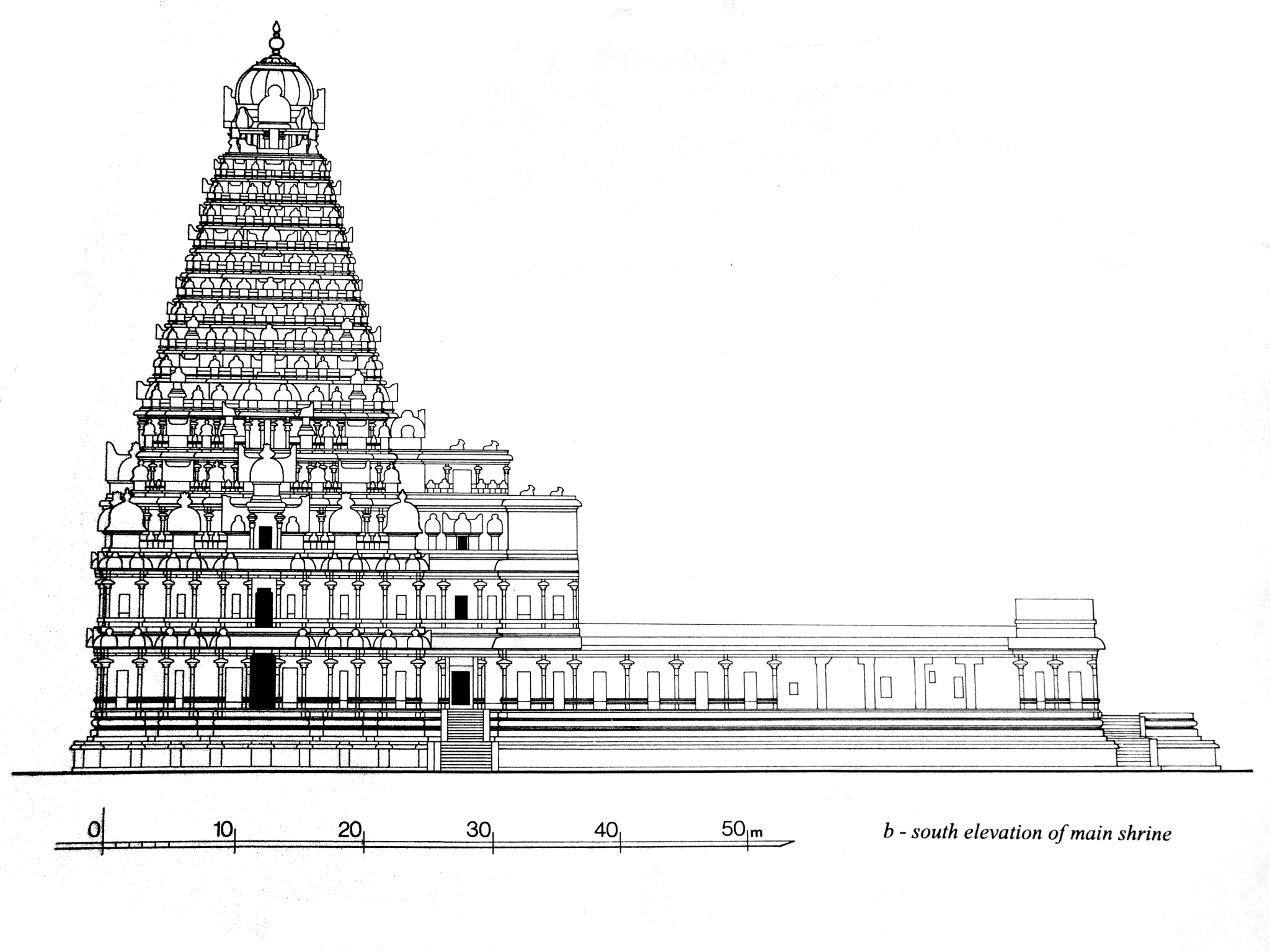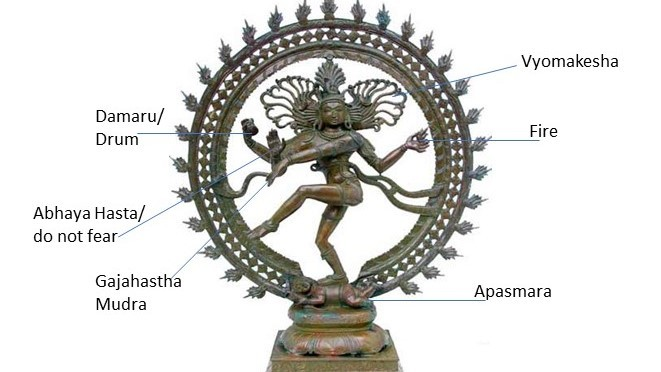Indian History
Raja Raja I and Chola Administration
- 26 Nov 2024
- 16 min read
For Prelims: Raja Raja Chola I, Thiruvalangadu Inscription, Battle of Kandalur Salai, Senur Inscription, Rajaraja Mandalam, Mummudi Chola, Cholas, Pandyas, Cheras, Chalukyas, Nagapattinam, Local Self-Government, Brihadeshwara Temple, Dravidian Temple Architecture, UNESCO, Gangaikonda Cholapuram, Airavateshvara Temple, Dakshina Meru, Mural Paintings, Bharatanatyam, Nataraja Statue, Ananda Tandava.
For Mains: Contribution of Chola dynasty in Indian history, Art & Architecture of Chola dynasty.
Why in News?
Recently, the birth anniversary of Chola emperor Raja Raja Chola I was celebrated during the Sadhaya Vizha festival (mid-October to mid-November) in Thanjavur, Tamil Nadu.
- He was born as Arulmozhi Varman in 947 CE and adopted the title "Rajaraja," meaning "King among Kings".
What are Key Facts About Rajaraja Chola I?
- About: Rajaraja Chola I was the third child of Parantaka Chola II and Vanavan Mahadevi.
- The Thiruvalangadu inscription credits Uttama Chola (predecessor) with appointing Arunmozhi (Rajaraja I) as his successor, recognising his extraordinary potential.
- He ruled from 985 to 1014 CE and was marked by military prowess and profound administrative vision.
- Notable Military Conquests:
- Battle of Kandalur Salai (988 CE): It was a naval battle against the Cheras (central and northern Kerala) at Kandalur in Kerala.
- It was the first military achievement of King Rajaraja I and resulted in the destruction of Chera naval forces and ports.
- Conquest of Kerala and the Pandyas: According to the Senur inscription (Tamil Nadu), Rajaraja Chola I destroyed the Pandya capital Madurai, and conquered Kollam.
- After victory, he took the title "Pandya Kulashani" (thunderbolt to the Pandyas) and renamed the region “Rajaraja Mandalam.”
- He also adopted the title "Mummudi Chola" (Chola who wears the three crowns) to signify his dominance over the Cholas, Pandyas, and Cheras.
- Victory in Sri Lanka (993 CE): Rajaraja Chola I invaded Sri Lanka in 993 CE and the northern half of Sri Lanka was captured and established Jananathamangalam as the provincial capital.
- The conquest was completed under his son Rajendra Chola I in 1017.
- Conflict with the Chalukyas: He defeated the Chalukyas in Karnataka, annexing regions like Gangavadi and Nolambapadi.
- He fostered alliances through strategic marriages, such as his daughter Kundavai's union with Vimaladitya of Vengi.
- Battle of Kandalur Salai (988 CE): It was a naval battle against the Cheras (central and northern Kerala) at Kandalur in Kerala.
- Chola Navy: Rajaraja Chola I strengthened the navy, earning the Bay of Bengal the title "Chola Lake."
- Nagapattinam (TN) served as the main port, supporting successful campaigns in Sri Lanka and the Maldives.
- Administration: Replaced hereditary lords with dependent officials and exercised direct control over provinces.
- He strengthened the system of local self-government and installed a system of audit and control through which the public bodies were kept under watch.
- Art & Culture: Rajaraja Chola I was a dedicated Shaivite, but he also dedicated several temples to Lord Vishnu.
- In 1010 CE, Rajaraja Chola I built the grand Brihadeshwara temple (Rajarajeshwaram temple) at Thanjavur. It is dedicated to lord Shiva and a perfect example of Dravidian temple architecture.
- The temple is part of the UNESCO world heritage and is known as one of the “Great Living Chola Temples” with the other two being the Gangaikonda Cholapuram and Airavateshvara temple.
- An important piece of Chola sculpture was the sculpture of Nataraja in the Tandava dance posture.
- In 1010 CE, Rajaraja Chola I built the grand Brihadeshwara temple (Rajarajeshwaram temple) at Thanjavur. It is dedicated to lord Shiva and a perfect example of Dravidian temple architecture.
- Coinage: Rajaraja Chola I introduced new coins featuring a standing king on one side and a seated goddess on the other, replacing the old tiger-emblem coins.
- His coins were also copied by the kings of Sri Lanka.
Note:
The Chola Empire was founded by Vijayalaya who led to the rise of the mighty Cholas by defeating the Pallavas.
- The reign of the Cholas (9th-13th Century) stretched over for over five long centuries until the 13th century.
What are Key Facts About the Chola Administration?
- Centralised Governance: At the top of the Chola administrative structure was the king whose powers were balanced by a council of ministers.
- The Central Government under the king had a structured council with higher officials (Peruntaram) and lower officials (Siruntaram).
- Provincial Administration: The Chola Empire was divided into nine provinces, also called Mandalams.
- The Mandalams were further subdivided into Kottams or Valanadus, which were further divided into Nadus (districts) and then into Urs (villages).
- Revenue System: The land revenue was the primary source of income with a general rate of 1/6th of the land yield collected as tax, either in cash, kind, or both.
- The Chola administration also levied taxes on customs, tolls, mines, ports, forests, and salt pans. Professional and house taxes were also collected.
- Local Administration: The most distinctive feature of the Chola administration was its local governance system, which granted substantial autonomy to local units like Nadus and Villages.
- The Nadu was an important administrative unit, with its own assembly, and was headed by the Nattar, while the council of Nattars was called the Nattavai.
- At the village level, the Grama Sabha was responsible for maintaining public infrastructure and regulating markets.
- The village assemblies were assisted by various Variyams (committees) responsible for different aspects of local governance.
- The Nadu was an important administrative unit, with its own assembly, and was headed by the Nattar, while the council of Nattars was called the Nattavai.
- Trade under the Chola Dynasty:
- Local Trade: The Chola Empire saw significant development in internal trade, facilitated by mercantile corporations and organized guilds.
- These guilds, often referred to as "nanadesis", were powerful and autonomous bodies of merchants.
- In large trade centers such as Kanchipuram and Mamallapuram, local merchant organizations called "nagaram" helped coordinate trade and market activities.
- Maritime Trade: Chola dynasty established trade relations with West Asia, China, and Southeast Asia.
- They were engaged in the lucrative trade of spices, precious stones, textiles, and other goods that were in demand across Asia.
- Local Trade: The Chola Empire saw significant development in internal trade, facilitated by mercantile corporations and organized guilds.
What are the Key Facts About the Brihadisvara Temple?
- About: The temple, built by Rajaraja I, was inaugurated in his 19th year (1003-1004 CE) and consecrated in his 25th year (1009-1010 CE).
- Architectural Significance: It exemplifies the pure form of Dravidian temple design.
- Architecture:
- Design: Features a massive colonnaded prakara (enclosure) with sub-shrines dedicated to the eight guardian deities (ashtadikpalas).
- Gopuram: Known as Rajarajantiruvasal, it serves as the grand gateway to the temple complex.
- Circumambulatory Path: A pathway surrounds the sanctum, allowing devotees to perform pradakshina (circumambulation) around the sacred shivlinga.
- Artistic Elements:
- Mural Paintings: The temple walls are adorned with expansive and exquisite mural paintings, including 81 of the 108 karanas (dance poses) from Bharatanatyam.
- A Mural depicting Raja Raja I and his guru Karuvuruvar found in the Brihadisvara temple, Tamil Nadu.
- Inscriptions: It contains inscriptions detailing Rajaraja Chola I's military achievements, temple grants, and administrative orders.
- Mural Paintings: The temple walls are adorned with expansive and exquisite mural paintings, including 81 of the 108 karanas (dance poses) from Bharatanatyam.
What are the Key Facts About the Nataraja Statue?
- About: The Nataraja statue symbolizes Lord Shiva as the cosmic dancer, embodying the creation, preservation, and destruction of the universe.
- Historical Origin: The earliest sculptures of Nataraja date back to the 5th century CE.
- The iconic and world-famous form evolved during the Chola dynasty's reign (9th–13th century CE), showcasing their artistic and cultural advancements.
- Cosmic Dance: Known as Ananda Tandava (Dance of Bliss), it represents the eternal rhythm of the universe, the cycle of creation and destruction, and the perpetual flow of time.
- Key Symbolic Features:
- Flaming Halo (Prabhamandala): Represents the cosmos and the cycle of time, destruction, and renewal.
- Damaru (Upper Right Hand): The hand drum symbolizes the first sound of creation and the rhythm of the universe.
- Agni (Upper Left Hand): The flame signifies destruction, marking the end of the cosmic cycle.
- Abhayamudra (Lower Right Hand): A gesture of reassurance and protection, dispelling fear.
- Left-Hand Gesture: Points to the raised left foot, symbolizing refuge and liberation for the troubled soul.
- Apasmara Purusha: The dwarf figure under Shiva’s right foot represents ignorance or illusion (maya) that leads humans astray.
- Raised Left Foot: Represents grace and the path to salvation.
- Chola Contributions: The Chola bronzes are renowned for their finesse, intricate detailing, and spiritual symbolism.
- It was crafted in bronze, showcasing the expertise of Chola-era metallurgists and artists.
- Recognition: A replica of the Nataraja statue stands outside CERN (European Organization for Nuclear Research), symbolizing the cosmic dance of particles in physics.
Maritime Activity Under the Chola Rule
- Naval Power: The Cholas built a powerful navy that extended to distant shores to conquer territories, promoting mercantile interests.
- Ports: Key ports include Mamallapuram (Mahabalipuram), Kaveripattinam, Nagapattinam, Kancheepuram, Kulachal, and Thootukodi.
- Invasion of Southeast Asia: King Rajendra I's invasion of the Sailendra Empire (Southeast Asia) brought the Malay Peninsula, Java, and Sumatra under Chola control.
- The Cholas thwarted Chinese attempts to disrupt their trade with Southeast Asia.
- Shipbuilding: Kappal Sattiram, a treatise on shipbuilding, highlights their advanced maritime technology.
Conclusion
- Rajaraja Chola I's reign marked a significant era in military, cultural, and maritime advancements. His contributions in administration, temple architecture, and naval power, along with the Chola maritime empire's expansion, showcase the empire's profound influence on South Asia and beyond, especially in fostering trade and cultural exchanges.
|
Drishti Mains Question: Discuss the Chola administration and aspects of its local administration. |
UPSC Civil Services Examination Previous Year Question (PYQ)
Prelims
Q. With reference to Chausath Yogini Temple situated near Morena, consider the following statements:
- It is a circular temple built during the reign of Kachchhapaghata Dynasty.
- It is the only circular temple built in India.
- It was meant to promote the Vaishnava cult in the region.
- Its design has given rise to a popular belief that it
- was the inspiration behind the Indian Parliament building.
Which of the statements given above are correct?
(a) 1 and 2
(b) 2 and 3 only
(c) 1 and 4
(d) 2, 3 and 4
Ans: (c)
Q. The Nagara, the Dravida and the Vesara are the (2012)
(a) three main racial groups of the Indian subcontinent
(b) three main linguistic divisions into which the
languages of India can be classified
(c) three main styles of Indian temple architecture
(d) three main musical Gharanas prevalent in India
Ans: (c)
Q. India maintained its early cultural contacts and trade links with Southeast Asia across the Bay of Bengal. For this pre-eminence of early maritime history of Bay of Bengal, which of the following could be the most convincing explanation/explanations? (2011)
(a) As compared to other countries, India had a better ship building technology in ancient and medieval times
(b) The rulers of southern India always patronized traders, Brahmin priests and Buddhist monks in this context
(c) Monsoon winds across the Bay of Bengal facilitated sea voyages
(d) Both (a) and (b) are convincing explanations in this context
Ans: (d)
Mains
Q: (a) Discuss the Tandava dance as recorded in the early Indian inscriptions.
(b) Chola architecture represents a high watermark in the evolution of temple architecture. Discuss. (2013)
Q. Indian philosophy and tradition played a significant role in conceiving and shaping the monuments and their art in India. Discuss. (2020)








-min.jpg)